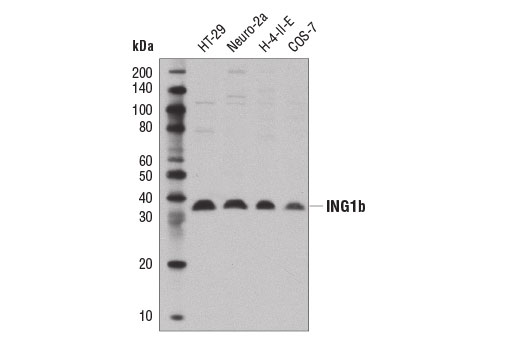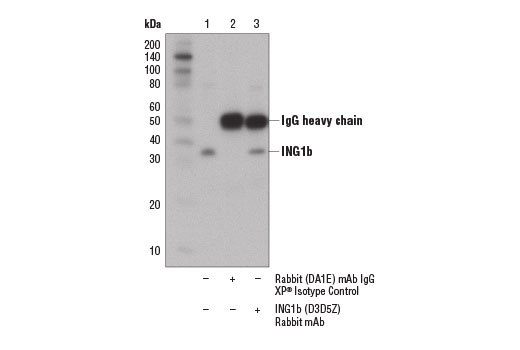WB, IP
H M R Mk
Endogenous
33
Rabbit IgG
#Q9UK53-2
3621
Product Information
Product Usage Information
| Application | Dilution |
|---|---|
| Western Blotting | 1:1000 |
| Immunoprecipitation | 1:50 |
Storage
Specificity / Sensitivity
Species Reactivity:
Human, Mouse, Rat, Monkey
Source / Purification
Monoclonal antibody is produced by immunizing animals with a synthetic peptide corresponding to residues near the amino terminus of human ING1b protein.
Background
Inhibitor of growth 1 (ING1) is a member of an evolutionarily conserved family of tumor suppressor proteins and transcription regulators (1,2). Differential mRNA splicing generates several ING1 isoforms, with the widely expressed ING1b (p33) isoform playing key roles in cell cycle regulation, apoptosis, and senescence (2-5). All ING family proteins contain a plant homeodomain (PHD) that is thought to recognize and bind methylated lysine residues on histone proteins (6,7). The ING1 protein regulates expression of genes through its association with histone acetyltransferase and deacetylase complexes. The PHD of ING1 may facilitate the recruitment of these chromatin-modifying enzymes to targets genes that are regulated by various transcription factors, such as p53 (2, 8-10). Consistent with its role as a tumor suppressor, alterations in ING1 expression levels and cytoplasm localization have been observed in several cancers but mutations in the corresponding ING1 gene in cancers are uncommon (11-14).
- Unoki, M. et al. (2009) Cancer Sci 100, 1173-9.
- Nouman, G.S. et al. (2003) J Clin Pathol 56, 491-6.
- Helbing, C.C. et al. (1997) Cancer Res 57, 1255-8.
- Shinoura, N. et al. (1999) Cancer Res 59, 5521-8.
- Abad, M. et al. (2011) Aging Cell 10, 158-71.
- Garkavtsev, I. et al. (1996) Nat Genet 14, 415-20.
- He, G.H. et al. (2005) Mol Biol Evol 22, 104-16.
- Pedeux, R. et al. (2005) Mol Cell Biol 25, 6639-48.
- Kuzmichev, A. et al. (2002) Mol Cell Biol 22, 835-48.
- Peña, P.V. et al. (2008) J Mol Biol 380, 303-12.
- Toyama, T. et al. (1999) Oncogene 18, 5187-93.
- Ohmori, M. et al. (1999) Am J Hematol 62, 118-9.
- Tallen, G. et al. (2004) Int J Cancer 109, 476-9.
- Li, X.H. et al. (2011) Histol Histopathol 26, 597-607.
Species Reactivity
Species reactivity is determined by testing in at least one approved application (e.g., western blot).
Western Blot Buffer
IMPORTANT: For western blots, incubate membrane with diluted primary antibody in 5% w/v BSA, 1X TBS, 0.1% Tween® 20 at 4°C with gentle shaking, overnight.
Applications Key
WB: Western Blotting IP: Immunoprecipitation
Cross-Reactivity Key
H: human M: mouse R: rat Hm: hamster Mk: monkey Vir: virus Mi: mink C: chicken Dm: D. melanogaster X: Xenopus Z: zebrafish B: bovine Dg: dog Pg: pig Sc: S. cerevisiae Ce: C. elegans Hr: horse GP: Guinea Pig Rab: rabbit All: all species expected
Trademarks and Patents
Limited Uses
Except as otherwise expressly agreed in a writing signed by a legally authorized representative of CST, the following terms apply to Products provided by CST, its affiliates or its distributors. Any Customer's terms and conditions that are in addition to, or different from, those contained herein, unless separately accepted in writing by a legally authorized representative of CST, are rejected and are of no force or effect.
Products are labeled with For Research Use Only or a similar labeling statement and have not been approved, cleared, or licensed by the FDA or other regulatory foreign or domestic entity, for any purpose. Customer shall not use any Product for any diagnostic or therapeutic purpose, or otherwise in any manner that conflicts with its labeling statement. Products sold or licensed by CST are provided for Customer as the end-user and solely for research and development uses. Any use of Product for diagnostic, prophylactic or therapeutic purposes, or any purchase of Product for resale (alone or as a component) or other commercial purpose, requires a separate license from CST. Customer shall (a) not sell, license, loan, donate or otherwise transfer or make available any Product to any third party, whether alone or in combination with other materials, or use the Products to manufacture any commercial products, (b) not copy, modify, reverse engineer, decompile, disassemble or otherwise attempt to discover the underlying structure or technology of the Products, or use the Products for the purpose of developing any products or services that would compete with CST products or services, (c) not alter or remove from the Products any trademarks, trade names, logos, patent or copyright notices or markings, (d) use the Products solely in accordance with CST Product Terms of Sale and any applicable documentation, and (e) comply with any license, terms of service or similar agreement with respect to any third party products or services used by Customer in connection with the Products.

